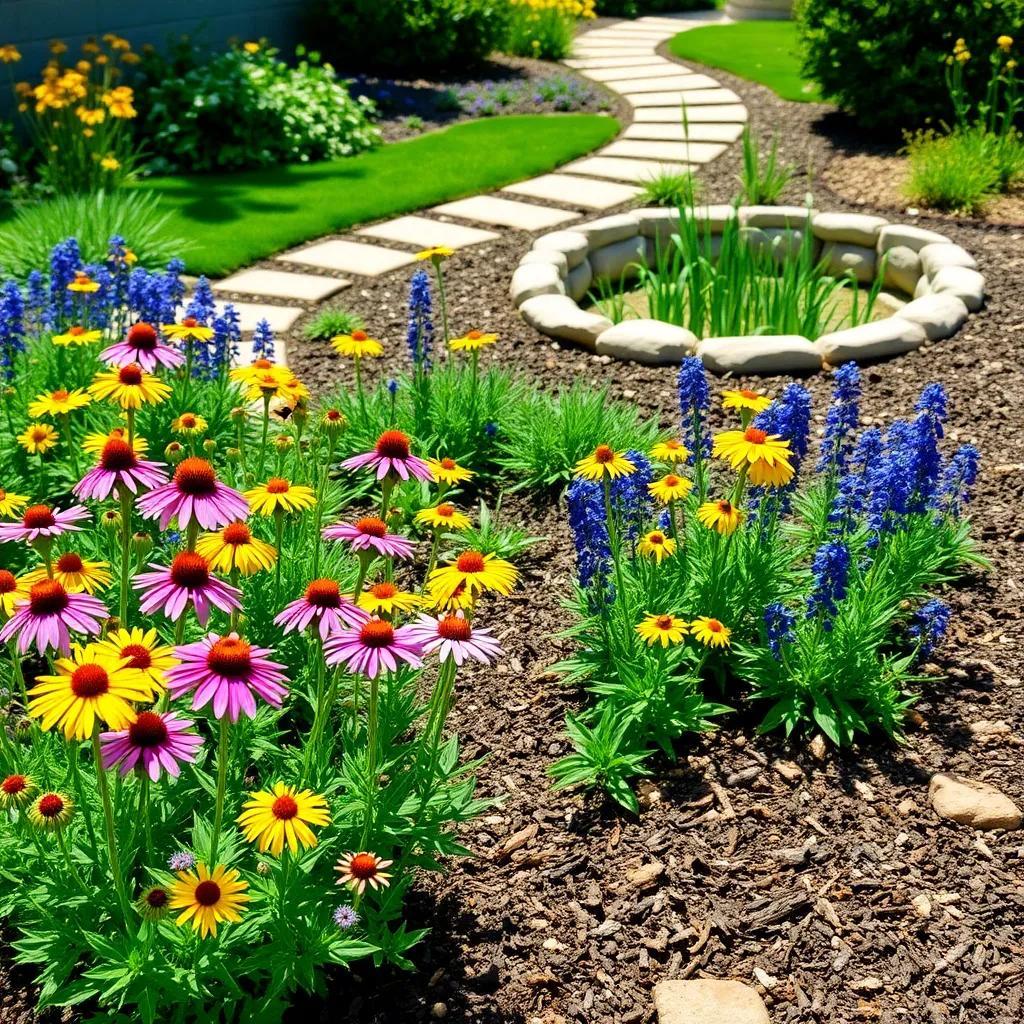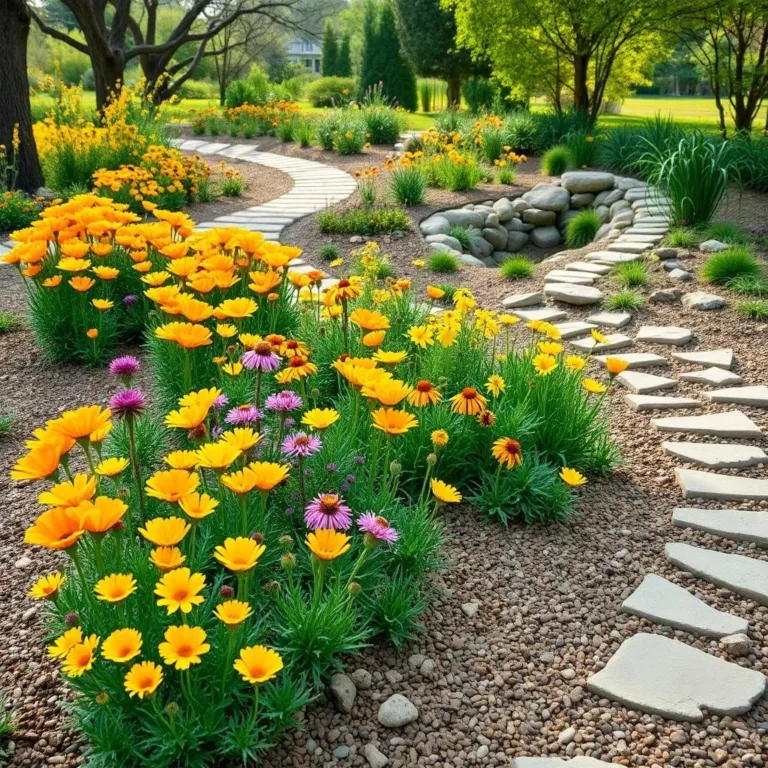Have you ever wondered how to create a beautiful garden that’s easy to care for and good for the planet? I’m excited to share with you the wonders of xeriscaping with native plants! It’s a smart and fun way to make your outdoor space thrive while saving water and supporting local wildlife. Let’s dig into the benefits and tricks of this incredible landscaping approach!
Benefits of Using Native Plants in Xeriscaping
When it comes to designing a beautiful and sustainable garden, native plants are like the superheroes of xeriscaping! They’re already perfectly suited to our local climate, which means they can thrive with little water and care. Here’s why I just love using them in my garden:
- Water Efficiency: Native plants have adapted to their environment, which makes them incredibly ready for dry conditions. Since they require less water, I can save on my water bills and help the planet too!
- Wildlife Habitat: By incorporating native plants, I am creating a friendly home for local wildlife. These plants provide food and shelter for pollinators like bees and butterflies. Who wouldn’t want to attract such beautiful creatures to their garden? It’s like hosting a backyard party for nature!
- Low Maintenance: Let’s be honest, who has time for endless upkeep? Native plants are generally low-maintenance, which means I can spend less time in the garden and more time enjoying it. They are tough cookies that can withstand local pests without needing chemical treatments!
- Aesthetic Appeal: With a variety of colors, shapes, and textures, native plants are simply gorgeous! They add character to my garden and often have cultural significance. Plus, I love introducing friends to the local beauty of our area through my plant choices!
- Soil Health: These plants have deep roots that help keep soil healthy and reduce erosion. Healthy soil is essential for a thriving garden and helps absorb rainfall effectively.
In short, using native plants in xeriscaping is not just good for the environment, it also makes gardening a breeze! So why not give your garden its well-deserved upgrade with these lovely locals?
Key Features of Xeriscaping vs. Traditional Landscaping
Alright, let’s get into the nitty-gritty of xeriscaping versus traditional landscaping! It’s like comparing apples to oranges, right? Both have their charm, but one is definitely a lot friendlier to our planet. Here are some key features that make xeriscaping stand out:
Xeriscaping:
- Water Efficiency: Xeriscaping shines in its water conservation methods. With drought-tolerant plants and smart design, water is used wisely. It’s more like a water-sipping garden, perfect for dry climates!
- Native Plants: Like I mentioned earlier, xeriscaping uses plants that are native to the area. These plants are already accustomed to local conditions, needing minimal care and resources.
- Smart Design: In a xeriscape garden, plant placement is planned carefully. Grouping plants with similar water needs together reduces waste. It’s all about creating harmony!
- Environmental Responsibility: This approach promotes eco-friendly gardening practices. By reducing chemical usage and resource consumption, I feel good about my impact on the Earth.
Traditional Landscaping:
- Water-Intensive: Traditional landscaping often requires a lot of water. Think of all those thirsty lawns! It can be tough, especially in arid regions where water is scarce.
- Non-Native Plants: Many traditional gardens use exotic plants that need extra care. These plants often rely on fertilizers and pesticides, which can harm the environment.
- Time-Consuming Maintenance: Regular mowing, trimming, and fertilizing can feel like a full-time job. Who has time for that? Traditional landscaping often demands more effort than xeriscaping!
In conclusion, while traditional landscaping can be lovely, xeriscaping offers a more sustainable and low-maintenance option. With xeriscaping, I can enjoy a beautiful garden that benefits both me and the environment! What’s not to love?

Environmental Impacts of Traditional Landscaping Practices
When we think about our gardens, it’s easy to focus on how pretty they look. But have you ever wondered about the environmental impacts of traditional landscaping practices? It turns out that maintaining those lush green lawns and exotic plants can have some not-so-great consequences for our planet! Let’s break it down:
- Water Consumption: Traditional landscaping often requires tons of water to keep those grass lawns and non-native plants looking their best. Regular irrigation can lead to wasted water and over time, this can contribute to water shortages, especially in dry regions. Who wants to stress about their water bill, right?
- Chemical Usage: Many traditional gardeners rely heavily on chemical fertilizers, pesticides, and herbicides. While these products can make plants look good at first, they can harm soil health and contaminate local water supplies. It’s a little scary to think about!
- Loss of Biodiversity: By planting mainly non-native species, we can actually harm local wildlife! Traditional gardens often don’t provide the food and habitat that our native pollinators and critters need. This can lead to a decline in biodiversity, making our ecosystems less resilient.
- Soil Erosion: Frequent lawn mowing and the use of heavy machinery can compact the soil and increase the risk of erosion. This is not just bad for the garden; it can also lead to sediment runoff that harms nearby streams and rivers.
By shifting our focus to more sustainable practices, like xeriscaping, we can make our gardens kinder to the environment. Trust me, making this change is a win-win for both us and our planet!
Water Conservation Strategies in Xeriscaping
One of the best parts about xeriscaping is the way it emphasizes water conservation! With some simple strategies, we can create vibrant gardens that need much less water than traditional landscaping. Here are my top tips for saving water while keeping your garden gorgeous:
- Choose Drought-Tolerant Plants: Start by selecting plants that are native to your area. These plants usually have deep root systems, which help them access water in the soil. Plus, they don’t need constant watering!
- Install Efficient Irrigation: If you need to water, using systems like drip irrigation or soaker hoses can make a huge difference. These systems deliver water right to the root zone of the plants, minimizing evaporation and runoff. It’s like giving your plants a refreshing drink without wasting a drop!
- Add Mulch: Applying a layer of organic mulch around your plants helps retain moisture in the soil. It also keeps the roots cool, which is essential for plant health. Plus, it looks nice and tidy!
- Smart Watering Techniques: Watering early in the morning or late in the evening can help reduce water loss due to evaporation. Deep, infrequent watering encourages plants to develop strong root systems, making them more resilient!
- Design with Water Efficiency in Mind: Grouping plants with similar water needs together is a smart way to maximize water use. I also love adding features like rain gardens to catch and soak up rainwater, reducing runoff and promoting natural hydration.
By implementing these water conservation strategies, I can create a beautiful xeriscape garden that keeps our water resources safe while thriving throughout the seasons!
How Xeriscaping Supports Local Wildlife and Ecosystems
Okay, let’s get down to one of my favorite parts about xeriscaping: how it supports local wildlife and ecosystems! Imagine a garden that not only looks good but also serves as a habitat for all sorts of critters. Here’s how this wonderful practice benefits our furry and feathered friends:
- Habitat Creation: When we use native plants in xeriscaping, we provide food, shelter, and nesting sites for many local animals. Birds, butterflies, and beneficial insects all find a welcoming home in these gardens. Who wouldn’t want to attract beautiful wildlife?
- Attracting Pollinators: Native plants produce flowers that are perfect for pollinators! Bees, butterflies, and hummingbirds absolutely love these plants, and by planting them, I’m helping to ensure these important species thrive. Pollinators are vital for plant reproduction, making them key players in our gardens and ecosystems!
- Biodiversity Boost: By incorporating a variety of native plants, I create a diverse ecosystem that supports different species. This diversity can help strengthen the local environment and make it more resilient against pests and disease.
- Reduction of Invasive Species: Planting natives helps keep invasive species at bay. Non-native plants can crowd out local flora, leaving less room for our cherished native species. My native garden can resist invasives better, promoting ecological balance!
- Soil Health Improvement: Native plants have deep roots that improve soil structure and promote nutrient cycling. Healthy soil supports a thriving ecosystem beneath the surface, which, in turn, benefits everything above ground.
By opting for xeriscaping with native plants, I’m not just decorating my yard—I’m creating a thriving environment that supports local wildlife and strengthens our ecosystem. How amazing is that? My garden is a true partnership with nature!

